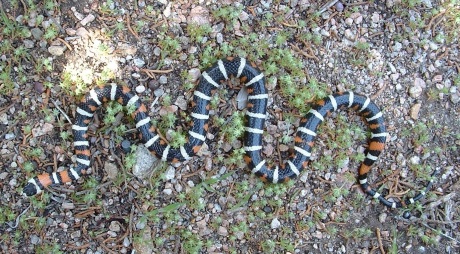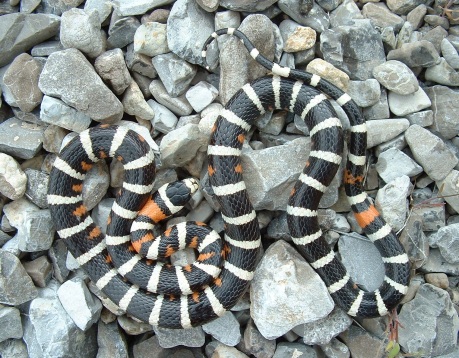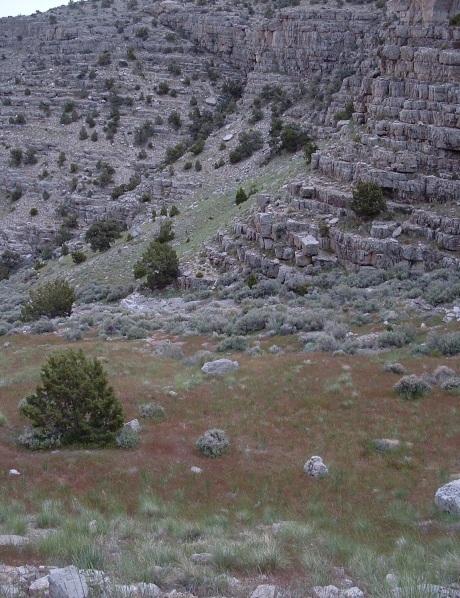special snakes, 2011
April 6, 2012
There may be a break for awhile in my posts here after this one. I’ll leave photos of other snakes and lizards from 2011 for future posts with whatever reptile photos I might gather during 2012. I have accumulated photos and observations of plants and insects that I anticipate presenting in posts here eventually.
But right now I would like to post here these four special snakes I came across in 2011. These were special because they were species I had never found alive in Utah before (the sidewinder and ringneck), or they were the first specimen of their species ever documented in their mountain range (the House and Confusion Ranges’ mountain kingsnakes).
There’s more text here between photos than in my other posts. I hope those comments might be interesting to some readers.
*
The first snake I’ll describe here is this sidewinder rattlesnake from SW Utah:

mid April 2011, sidewinder rattler (Crotalus cerastes), adult w/ recent meal, Babylon area, Washington Co, UT
I regret I did not obtain a photo of this specimen as found. As I came upon it, it was coiled tightly in the sun, amid some strands of cheatgrass poking out of the sand. But as it noticed me it uncoiled, and I took these quick shots.
Other photographers obtain much nicer shots of this species, but I think it’s less common to find one while walking (as I found this one) than while driving along a road. I believe this one was near the northern edge of the species’ range in Utah.
*

mid April 2011, sidewinder rattler (Crotalus cerastes), adult w/ recent meal, dorsal, Babylon area, Washington Co, UT
Here is a dorsal shot that shows how large its recently swallowed food item was, in relation to the size of its head and neck.
This snake seemed perturbed little by the presence of a friend and me, as we took some photos. In fact, as I walked away I watched it recoil exactly where I’d found it. I had expected that after its disturbance by us it would instead seek shelter in the shade under a rocky protrusion that was less than 0.5m away. But I guess it was glad to remain in the sunlight and absorb heat to help digest its big meal.
*
*
The second snake in this post is this adult female utah mountain kingsnake, the first of its species formally documented in Millard County’s House Range:

mid May 2011, utah mountain kingsnake (Lampropeltis pyromelana infralabialis), adult female (a), Southern House Range, Millard Co, UT
One goal of my weekend excursions has been to document (through photovouchering and subsequent museum accession) the existence of Utah’s mountain kingsnakes in ranges where the species has not yet been proven to occur. I began this in 2002, and since then have learned several lessons: (1) You can very easily fail to find this secretive species when you spend time looking in documented ranges. (2) The habitats and the groups of associated plant and reptile species very similar to those found in documented ranges also occur in many undocumented ranges. (3) This species occurs in a broader span of habitat types than was relatively recently understood.
I used to think that in the Great Basin it was restricted to areas with igneous or metamorphic rock, but have learned of its occurrence in places with shale or gray limestone or red sandstone. I used to imagine it required access to at least seasonal surface water, but I have now found it in places with no apparent surface water within miles, during any part of the year. Perhaps it may be able to reach higher population density where water is more abundant or predominant rock is not sedimentary? This species competes with other snake species, and mechanisms involved in that can only be guessed. Perhaps in some places with less favorable habitat, one reason it persists is lessened competition for food from other snake species?
Lizards presumably comprise most of its diet, especially when the snakes are younger and too small to subdue and ingest small mammals and small birds. But it does not seem picky about which species of lizard it prefers. It can be found in areas of higher elevation, where sagebrush lizards are the only apparent lizard species, or at lower elevations below sagebrush lizards’–where fence, sideblotch and whiptail lizards could constitute prey. It probably feeds on skink lizards when it can, but probably does not require that prey species. It can share habitat with collared lizards, or it can live in shadier and more vegetated areas that lack collared lizards. Like most species in the genus Lampropeltis (but not like the snake-eating L. getula), these mountain kingsnakes do not seem to feed on other snakes. Sometimes they share Great Basin habitat with wandering gartersnakes, but they utilize other areas too dry for gartersnakes. They routinely (perhaps always?) share Great Basin habitat with these three more-easily-seen species: great basin gophersnake, great basin rattler, and striped whipsnake.
After I learned in 2008 how dry some utah mountain king snake habitat is in eastern Nevada, I shifted my opinion of the species’ potential existence in Utah’s House Range from ‘improbable’ to ‘very likely.’ Following about 20 full days’ worth of walking in the House Range (that began in 2003), I found this female there in mid May 2011. After I found her, I shifted my opinion of the species’ potential existence in Utah’s even-drier Confusion Range from ‘improbable’ to ‘likely,’ and I found the Confusion Range male in late May 2011. (He’s shown later in this post.) I found him after having spent about 6 full days (beginning in 2008) hiking in the Confusion Range.
Here are some more shots of the Southern House Range female.
*

mid May 2011, utah mountain kingsnake (Lampropeltis pyromelana infralabialis), adult female (b), Southern House Range, Millard Co, UT
*

mid May 2011, utah mountain kingsnake (Lampropeltis pyromelana infralabialis), adult female, under branch, Southern House Range, Millard Co, UT
*

mid May 2011, utah mountain kingsnake (Lampropeltis pyromelana infralabialis), adult female, in dappled shade of pinion, Southern House Range, Millard Co, UT
I placed her in pine needles in dappled shade, to see how she appeared on this background.
*

mid May 2011, utah mountain kingsnake (Lampropeltis pyromelana infralabialis), adult female, in hand, Southern House Range, Millard Co, UT
A friend who works for Utah’s state wildlife agency (UDWR) was hiking nearby, and when I found this snake and called out to him he joined me to help record measurements and photos. Here she is in his hands.
*

mid May 2011, habitat of utah mountain kingsnake (Lampropeltis pyromelana infralabialis), adult female, Southern House Range, Millard Co, UT
This is the habitat where I found her. She was coiled at the edge of a rock, partly in the clear sky’s noontime sunlight and partly under the shady rock. It occurred to me she might have kept this position in order to ambush lizards as those lizards sought shade or shelter under that rock later that day. Or, maybe she liked that spot simply because she could very easily adjust to her preferred temperature there where full sunlight was only a few cm away from full shade.
*
The third snake I’ll describe here is this adult male utah mountain kingsnake, the first of its species formally documented in Millard County’s Confusion Range:

late May 2011, utah mountain kingsnake (Lampropeltis pyromelana infralabialis), adult male (a), Confusion Range, Millard Co, UT
When I first saw him crawling along the wash, air temperature was 59F and it had begun to rain lightly. Notice the raindrop on him here that I neglected to wipe off.
*

late May 2011, utah mountain kingsnake (Lampropeltis pyromelana infralabialis), adult male (b), Confusion Range, Millard Co, UT
This view I’ve included because it shows his side more, with its orange rings reduced to small wedges by the encroaching black. Most utah mountain kingsnakes are not as black as he is. He’s the blackest one I’ve ever seen. Notice he’s more slender than the chubby female shown earlier.
*
When I first saw him, he was crawling right here, in the cheatgrass in the dry wash. Later I staged this shot to record approximately how he looked as I first saw him. The cheatgrass that is pushed down near his head was pushed down when I scooped him up the first time. I did that after he began to dart toward the base of that sagebrush.

late May 2011, utah mountain kingsnake (Lampropeltis pyromelana infralabialis), adult male as found, Confusion Range, Millard Co, UT
*

late May 2011, habitat of utah mountain kingsnake (Lampropeltis pyromelana infralabialis), adult male, Confusion Range, Millard Co, UT
The presence of utah mountain kingsnakes in Great Basin habitat as dry as this is something I would not have believed ten years ago–based on opinions from people with more field experience than I, and based on summaries in field guides of the species’ habitat requirements. There are undoubtedly more mountain ranges in Utah where this species occurs but has not yet been documented. Much previous documentation has occurred along paved roads, but some discrete ranges in Utah that hold appropriate habitat lack paved roads into that habitat. Actually, finding them crossing paved roads, even during conditions that seem likeliest, can be haphazard. Just because they have never been documented along an often-driven paved road is not proof that they don’t use the habitat along that road. Documented sightings have failed to occur on certain often-driven paved roads that cross habitat that is surely contiguous with documented habitat. In addition to some undocumented Utah ranges I would categorize as ‘virtually certain’ to hold this species, there’s another tier of undocumented ranges I would categorize as ‘possible & worth looking in.’ The same surely applies to the state of Nevada.
Of course, there are other Great Basin snake species besides mountain kingsnakes that occur in ranges and counties where they have not yet been documented. Nightsnakes and ring-necked snakes are small & drably colored (from the top) and possess secretive natures roughly similar to that of mountain kingsnakes with which they can share habitat. Utah’s milksnakes (L. triangulum taylori) ought to occur in undocumented foothill and higher valley areas in western Utah–based on their presence in extreme eastern Nevada that was published a few years ago. And the common/california kingsnakes (L. getula californiae) of southern Utah probably occur in counties north of their currently documented northern limit.
Looks to me as though there are some lifetimes’ worth of Great Basin reptile range extensions still to be filled in. Professional biologists have spent relatively little time in the field with the goal of documenting occurrence of “nongame” species that are not understood to be in jeopardy of federally threatened status. Fieldwork efforts toward most reptile species in the western USA have received little funding during decades of tight budgets. Hmm…and after global climate change has altered Great Basin habitats, how well will anyone know what harder-to-find species’ “baseline” geographic ranges and utilized habitat types had been prior to that change?
*
The fourth and final snake I’ll describe in this post is this adult ring-necked snake. I had found this species in Utah only once before–an adult male recently run over on a dirt road in rolling red rock sandstone habitat below 4,000 ft elevation. That was much different habitat than the steep limestone habitat near 7,000 ft where I found this adult female. This species’ occurrence in Tooele County’s western Oquirrh Mtns had been previously documented, although not for decades. I believe all ring-necked snake specimens known from Utah have been–like this one–ringless.

early July 2011, regal ring-necked snake (Diadophis punctatus regalis), adult female, in sunlight, W Oquirrh Mtns, Tooele Co, UT
*

early July 2011, habitat of regal ring-necked snake (Diadophis punctatus regalis), basking adult female, W Oquirrh Mtns, Tooele Co, UT
*

early July 2011, regal ring-necked snake (Diadophis punctatus regalis), adult female, in shade (a), W Oquirrh Mtns, Tooele Co, UT
*

early July 2011, regal ring-necked snake (Diadophis punctatus regalis), adult female, in shade (b), W Oquirrh Mtns, Tooele Co, UT
*

early July 2011, regal ring-necked snake (Diadophis punctatus regalis), adult female, in shade (c), W Oquirrh Mtns, Tooele Co, UT
*
I have submitted these specimens’ photos to a Utah museum’s herpetological collection, and have supplied other sightings information, so that these specimens now constitute museum-accessioned vouchers. In Utah now, without a special permit one can collect photographs of live specimens of most reptile species, including from some lesser-understood species that used to be illegal to touch or manipulate at all in the field. What I mean is one can briefly and gently handle the live animal to get a good look at it, to record photos and non-invasive measurements, and then release it where you found it. Please check the state rules to understand what activity is allowed and what is not, with which species. (Of course you might also want to educate yourself regarding which species’ bites can be venomous, and learn about other hazards you might encounter in remote areas.) One reason I’m presenting these observations here is to encourage others to voluntarily gather and submit such reptile sightings. To be useful, photos simply need to be good enough to unambiguously identify the species.
Here’s a final shot of the Oquirrhs ringneck:

early July 2011, regal ring-necked snake (Diadophis punctatus regalis), adult female, in shade (d), W Oquirrh Mtns, Tooele Co, UT
*
Tangential comment: My 2001-model Fuji Finepix 2800Z camera, with which I took this blog’s photos during 2006-2011, has begun to falter in new ways. So I checked online and learned the routine price advertised for used 2800Zs is only $35–hah! Its media cards sell for more at $50@. Maybe I can afford a replacement camera.
*

Fantastic job last year! I really like those shots of the ring-necked snake especially the first. I am going to have to join you one of these times for a mountain kingsnake hike. It is a species I have yet to see in the wild. Thanks for sharing
I meant the second shot of the ring-necked snake.
Beautiful pics. and documetations. I grew up in Nevada and only dreamed of documenting “pyromelana” in eastern Nevada. I now live in central Arizona where I find them occasionally. They look darker, more black-banded in the north of their extremes.
Great to see someone documenting the plants and reptiles of the Great Basin region.